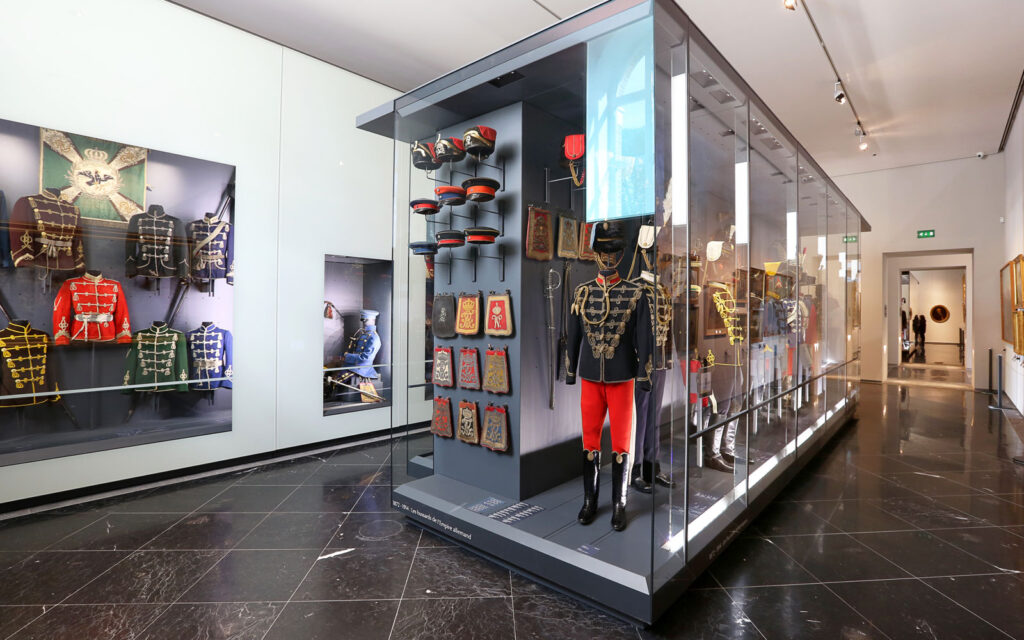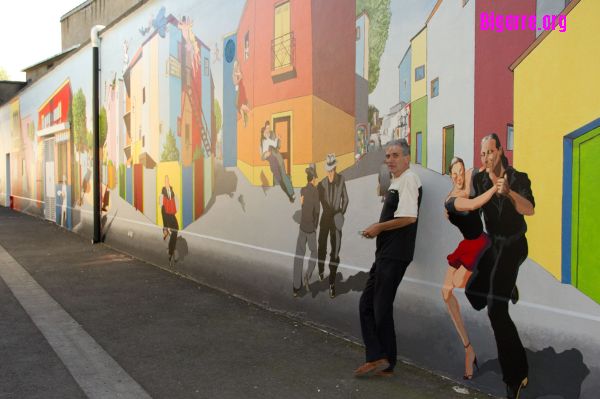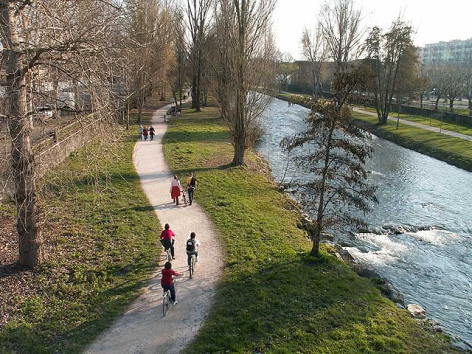
Tarbes, a dynamic city full of charm, offers a harmonious blend of heritage, culture and nature. A trip to Tarbes is an immersion in a lively city, rich in traditions and discoveries. The impressive National Stud bears witness to the region's rich equestrian tradition, while the Massey Museum exhibits important collections of local history and regional art. Gourmets will not want to miss the Brauhauban market, where local flavours take pride of place. Tarbes is also a festive town, with unmissable events such as the "Equestria" festival and Tarbes en Tango. So, what to do and see in Tarbes? In this article, we take a look at the 15 must-sees when visiting Tarbes.
1. The impressive Tarbes National Stud

Horses have always played a central role in Tarbes. The Haras de Tarbes, the cradle of the Anglo-Arabic breed from the Tarbes horse, is an emblematic site located in the heart of the town and listed as a historic monument. It is home to the Brigade Equestre Municipale, a Section Equestre Militaire and two resident equestrian artists. You can explore the Empire-style stables, the main saddlery and the farriery. The site is also home to one of the last remaining Ratouin riding arenas, with its 42-metre hall. Guided tours and themed visits are available to discover this exceptional site.
2. Jardin Massey, awarded the Jardin Remarquable label: a true haven of peace

Jardin Massey, which has been awarded the Jardin Remarquable label, invites you to discoverits 50,000 flowering bedding plants- an unforgettable experience! A veritable ark of nature, both lush and tamed, this garden is both the green lung and the precious heart of Tarbes. Its soft-green lawns are criss-crossed byavenues lined with centuries-old trees, including Siberian elms, giant sequoia, large-flowered magnolias and maples, some of which have been casting their beneficent shade for over 150 years. Two lakes and streams running over pebbles attract birds and turtles, while peacocks display their shimmering feathers in front of the architecturally remarkable orange grove.A small animal park with dwarf goats delights the youngest guests, who can also have fun in the playground dedicated to them.
Good to know: Jardin Massey, a public park, is also home tothe Musée Massey or Musée International des Hussards, a magnificent building with Hispano-Moorish influences, making this site a major must-see.
3. Musée Massey or Musée international des hussards

The elite troop of the Hussards, the stuff of fantasy, remains fascinating to this day. While art has freely drawn on the myths of this light cavalry corps, a museum was needed to capture its full complexity. Located in the heart of the Jardin Massey, the museum houses an exceptional collection of over 15,000 objects from all over the world, immersing you in this military universe. In chronological order, we follow them from the Ancien Régime to the Second World War, through the 34 countries they have visited. The museum's international reputation lies in the richness of its exhibits, its iconographic collection of drawings and paintings, its 130 mannequins and busts, and its many specific pieces of equipment.
Good to know: Legend has it that these warriors didn't get off their horses to sleep... In any case, they'll keep you awake in this museum, as their saga is so exciting!
4. Visit the Museum of Deportation and Resistance

Located in a former school in Tarbes, the Musée de la Déportation et de la Résistance was created by the Association des Déportés et Internés. It traces the history of the Second World War, with a particular focus on events in the Hautes-Pyrénées. Through photographs, original objects from the camps and the Resistance, and period documents, the museum offers a poignant insight into this dark period. A special section is dedicated to the smugglers who courageously helped those fleeing the Nazi regime to cross the Spanish border.
5. Visit the birthplace of Marshal Foch

Ferdinand Foch's birthplace, a typical Bigourdane house, is steeped in history. This 18th-century residence, although altered over the years, was the birthplace of Ferdinand Foch, Marshal of France, who distinguished himself in the First World War. This museum offers a poignant reminder of history, and a chance to discover this military strategist, famous for his daring and visionary spirit, who was both behind and ahead of his time. For his exploits, he was honored by being named Marshal of France, Great Britain and Poland.
6. See Notre-Dame-de-La-Sède cathedral

In the heart of Tarbes stands the magnificent Notre-Dame-de-La-Sède cathedral, a 12th-century Romanesque edifice accessible via a charming little cobbled square. The cathedral retains two choir apses from its original splendor, as well as an outer bay and a Gothic nave, despite its somewhat rugged appearance. Among its treasures are a gilded altarpiece in the nave's southern absidiole, a chapel dedicated to the Virgin, and a high altar topped by a large Baroque marble baldachin. These features alone justify a visit to this place of timeless charm.
7. A horse-drawn carriage tour of Tarbes: an unusual activity

Philippe Daunis is a fixture in Tarbes. With his horses Cooper and César, he invites you aboard his horse-drawn carriage for a one-hour tour of the town, starting at Jardin Massey. Upon reservation, Philippe also offers a picnic on board his horse-drawn carriage. The lunch, prepared by a local restaurateur, includes delicious duck breast or duck confit accompanied by sautéed potatoes, to be enjoyed while discovering the city. Or opt for an early-morning gourmet stroll with a tasting at Conserverie Hérau.
8. Stop by Tarbes Tourist Office

TheTarbes Tourist Office is an essential partner for discovering the town and its major annual events. Tarbes is a dynamic city that moves, creates and shines through events such as the Festival de Polyphonies Tarba en Canta and the Fêtes de Tarbes in June, Équestria in July, and the Festival Tarbes en Tango in August. Don 't miss a visit to the exhibition hall, where local artists are showcased in high-quality exhibitions. The Tourist Office can also provide you with detailed hiking maps of the surrounding area.
Related article what to do in the Hautes-Pyrénées? The 17 most beautiful places to visit
9. Walking in the most beautiful corners of the area

In collaboration with the Office National des Forêts, the Tarbes conurbation has developed a network of 10 walking loops, linking 15 communes over a distance of around 140 km. These signposted trails, accessible to pedestrians and cyclists, cross rural and urban areas, offering views of the local cultural and natural heritage. Explanatory panels dot the routes. The TLP Mobilités transport network facilitates access to the loops, with stops indicated on signs and leaflets. The Trait vert has parking areas so that you can follow it in dotted lines
10. Feasting at the Brauhauban market

Located right in the center of town, Marché Brauhauban has for decades combined the advantages of a neighborhood grocery store with those of local producers. With over 3,000 m² of floor space, it offers everything you need to fill your shopping basket : fruit and vegetables, meat and fish, cheeses, artisanal products and much more. Let yourself be enchanted by the mix of smells and lively exchanges of the merchants, whose loud, thundering voices echo throughout the market. You might even be challenged by their friendly apostrophes! Please note that the Brauhauban market has a covered pay parking lot.
11. See the Caminito mural

The Festival International de Tango Argentin has made Tarbes a central location for this discipline. In 2011, the town council decided to celebrate this link between the city and dance. In the little Rue Saint-Pierre, a 31 x 4.20-metre trompe-l'œil fresco depicts the La Boca district, located at the mouth of the Riachuelo river. Caminito, which means "little path", refers both to this poor district of Buenos Aires and to a famous tango composed in 1926. Alain Laborde's work tells the story of Argentina through emblematic elements such as soccer, ceibo flowers, tangueros and the country's national bird.
12. For horse-riding enthusiasts: join the Comité Départemental du Tourisme Equestre volunteer association

TheComité Départemental du Tourisme Equestre (CDTE 65) is avoluntary association whose mission is to promote and organize horse-riding tourism in the Hautes-Pyrénées. The department offers riders over 1,500 kilometers of equestrian trails, spread over more than 150 itineraries. The CDTE 65 can help you organize your ride, helping you choose the circuit that's right for you and providing information on specialized addresses. Whether you're looking for accommodation for you and your horse, refreshment points, or specialized craftsmen such as saddlers or farriers, you'll have access to all the right addresses.
13. Enjoy the calm and serenity of Tarbes' Bel Air park

The Parc Bel Air in Tarbes is a haven of peace, renowned for its tamarisk trees and children's playground. This peaceful, unspoilt setting contributes to the charm of Tarbes' green spaces. Calm and serenity reign here, particularly at the foot of the imposing Cedar of Lebanon, which majestically dominates the other trees, some of which are over a hundred years old, such as the tamarisk. Formerly part of the Villa Bel-Air built in 1860, the park's surface area has been reduced by two-thirds. Nevertheless, it remains one of the town's main green spaces, with a vast central lawn offering a breathtaking view of the Pyrenees mountain range. The children's playground also makes it a privileged family spot.
14. Stroll along the Caminadour

The Caminadour crosses Tarbes following the course of the river. The riverbanks have been designed to be accessible to people with reduced mobility, as well as to joggers, cyclists, hikers, strollers and walkers of all kinds. The path leads down to the Soues lake, a favorite with anglers, or up to the Bours lake. Educational and informative panels, as well as orientation tables, present the site and the trail. The tumultuous course of the Adour and the surrounding vegetation quickly make you forget the city.
15. The Maison du Parc National des Pyrénées in Tarbes

The Maison du Parc in Tarbes featuresexhibitions detailing the various missions of the Pyrenees National Park, as well as film screenings on the park and its natural heritage, available on request. As a reception and information area, it also offers the possibility of consulting documentation on the natural and cultural riches of the park's valleys, the refuges, and the regulations in force.
Read the article top 13 hikes in the Pyrenees
Where to stay in Tarbes?
Tarbes offers several accommodation options for visitors. Here are our favorites:
- Petit Futé's favorite: the Nex Hôtel
A real "coup de coeur" for this star-rated luxury hotel offering 55 modern rooms with walk-in showers, which you can book here. All rooms are soundproofed and air-conditioned, with walk-in showers and bathrooms that reflect luxury in every detail. A beautiful address where service is as efficient as the smile is warm.
- A cozy, central option: Hotel La Croix Blanche
Bookable right here, the Hôtel La Croix Blanche is a small, charming hotel with well-appointed, well-equipped rooms located on Place de Verdun, in the heart of Tarbes. The rooms are spacious and perfectly soundproofed, some with a breathtaking view of the square, others overlooking a quiet pedestrian street.
- The grandest: the Rex Hotel
The Rex Hotel in Tarbes is an exceptional venue that you can book right here . Its unique and impressive facade is adorned with sumptuous lights at nightfall, creating an atmosphere of romance and enchantment. When you stay at the Rex Hotel, you'll experience a truly out-of-the-ordinary place, with its contemporary design and elegant furnishings.
What to do in Tarbes when it rains?
When it rains in Tarbes, there are plenty of indoor activities to enjoy. Here are a few suggestions:
Visit the city's museums:
- Musée Massey: Discover local history and regional art through impressive collections.
- Musée de la Déportation et de la Résistance: Immerse yourself in the history of the Second World War and local events.
- Musée International des Hussards: Explore the fascinating history of this light cavalry corps.
Discover historic sites:
- Notre-Dame-de-La-Sède Cathedral: Admire the Romanesque and Gothic architecture of this magnificent cathedral.
- Haras National de Tarbes: Discover the region's equestrian history and Empire-style stables.
What activities are available in Tarbes for young people?
Tarbes offers a variety of activities suitable for young people, whether they're looking for entertainment, culture or sports. Here are a few suggestions:
Sports activities:
- Parc Bel Air: Enjoy the green spaces and children's play areas.
- Indoor pools: Swim a few laps or take part in water activities.
- Sports fields: Play soccer, basketball or other team sports at local facilities.
- Hiking and walking: Explore the Caminadour trails or the hiking paths around Tarbes.
The best activities for young people to book: You can also book right here a half-day rafting trip on the Gave de Pau river near Lourdes or try a via ferrata initiation in the Pyrenees National Park, bookable right here and accessible to the whole family!
For thrill-seekers: Want to soar above the exceptional panorama offered by the peaks of the Hautes-Pyrénées? Discover paragliding near Bagnères-de-Bigorre by clicking right here.
Cultural activities:
- Musée Massey: Discover local history and regional art through impressive collections.
- Musée de la Déportation et de la Résistance: Immerse yourself in the history of the Second World War and local events.
- Musée International des Hussards: Explore the fascinating history of this light cavalry corps.
- Théâtre des Nouveautés: Take in a play or show.
- Cinéma: Enjoy a movie at one of the city's cinemas.
Outdoor activities:
- Jardin Massey: Stroll through this magnificent garden and enjoy its green spaces.
- Fitness trail: Use the outdoor fitness facilities to keep in shape.
- Picnics: Organize a picnic in one of the city's parks with friends.
Events and festivals:
- Festival Equestria: Take part in this famous equestrian festival in July.
- Tarbes en Tango: Discover tango culture at this festival in August.
- Fêtes de Tarbes: Enjoy entertainment and shows at local festivals in June.
In short, Tarbes offers a multitude of activities for young people, whether they're interested in sport, culture, leisure or festive events.
What are the most beautiful villages to visit around Tarbes?
Around Tarbes, there are many picturesque villages worth visiting for their charm, history and natural heritage. Here are some of the most beautiful villages to discover:
- Lourdes: Although larger than a simple village, Lourdes is world-famous for its shrines and Marian apparitions. It's a must-see pilgrimage site with a unique atmosphere. Discover our article on What to do and see in Lourdes? The 11 must-sees.
- Cauterets cauterets: located in the Pyrenees, this village is renowned for its thermal baths and mountain scenery. It's an ideal starting point for hiking and outdoor activities in one of the most beautiful parts of the Pyrenees.
- Saint-Savin saint-Savin: this small village is famous for its Benedictine abbey, a masterpiece of Romanesque art. The abbey's frescoes are particularly remarkable.
- Gavarnie: Located in the heart of the Pyrenees, Gavarnie is famous for its natural cirque, a giant amphitheater carved out by glacial erosion. The village itself is charming and offers numerous hiking possibilities.
- Luz-Saint-Sauveur: This village in the Hautes-Pyrénées is famous for its thermal waters and mountain scenery. It is also a starting point for many mountain excursions.
- Arreau: Located in the Aure valley, Arreau is a picturesque village with stone houses and slate roofs. It is surrounded by magnificent mountain scenery


